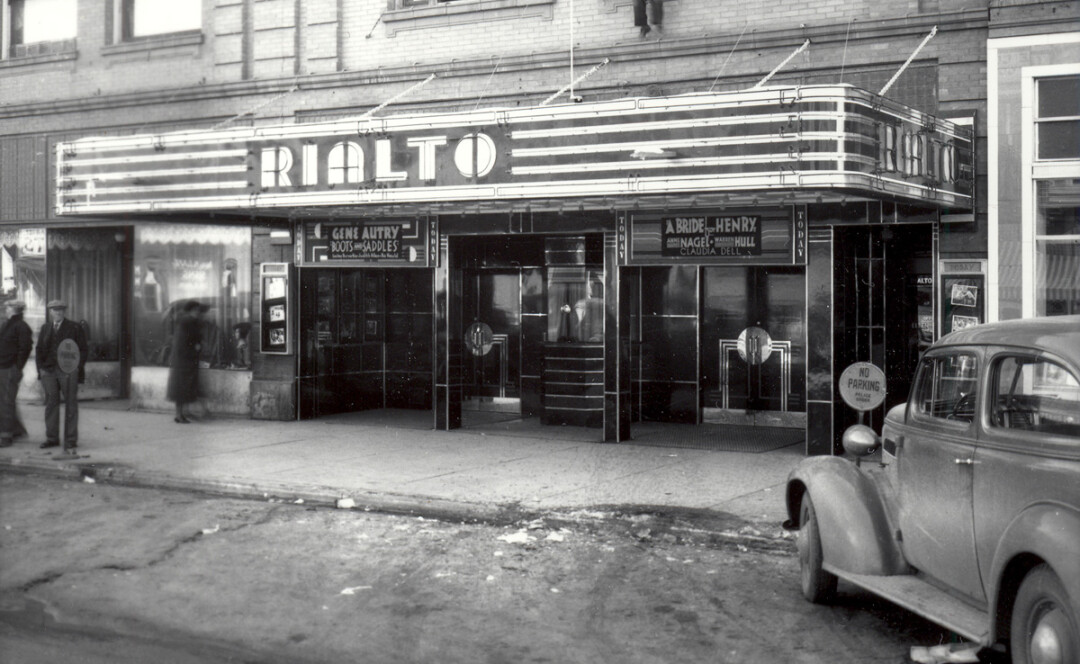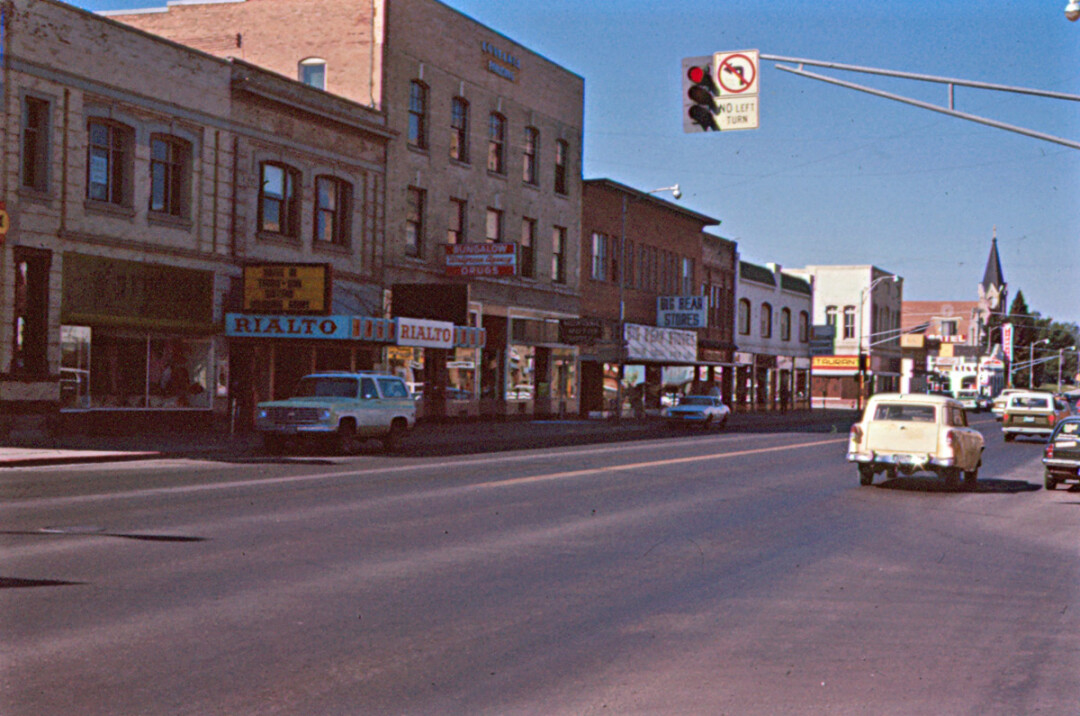The Rialto Remembered
Bozeman’s Choice Business or Structure You Wish Was STILL Here But Is Gone
In 1922, the Rialto Theater opened for business in downtown Bozeman while the Roaring Twenties pop culture spread across America. In national entertainment news, Italian-born heartthrob Rudolph Valentino starred in the silent film Beyond the Rocks. Rising actress Ethel Barrymore performed in a live production of Romeo and Juliet in New York City, and Chicago rose as a jazz hotspot. Speakeasy clubs multiplied as the United States entered its third year of Prohibition. The addition of the Rialto to Bozeman’s theater scene coincided with this new era in entertainment.

Though far from the trendy clubs and famous playhouses in Chicago and New York, Bozeman always enjoyed its share of live plays and film screenings. The Bozeman Opera House occupied the second floor of the 1890 City Hall building, located on the southwest corner of Main Street and Rouse Avenue. In the early days, the theater attracted hundreds of traveling plays, vaudeville acts, musical groups, and famous stage personalities. Motion pictures arrived in the early 1900s, sparking the formation of new theaters that boasted whimsical names like the Star, Gem, Globe, Orpheum, and Lyric. These theaters could accommodate both moving pictures and live shows.
The grand opening of Bozeman’s Ellen Theater in 1919 marked a local shift in the entertainment landscape from small show houses to classy theaters. Often overshadowed by its more famous sister, the Rialto Theater started conservatively. Percy C. Hurst, the Rialto’s first manager, leased space in the Bozeman Opera House in 1922. Like many show houses of the day, Hurst’s theater accommodated both vaudeville and motion pictures. In 1923, local draftsman Alexander Milan Russell partnered with Hurst as co-manager of the Rialto. Before Russell entered the theater business, he gained top-notch building design experience working for famed local architect Fred Willson. In Willson’s employ, Russell helped design such buildings as Emerson School (now the Emerson Cultural Center) and the Ellen Theater.
Russell soon bought Hurst’s interests in the Rialto and became the theater’s sole owner. He renovated a former post office building at 10 West Main Street and moved the business into its own space in the heart of downtown. The Rialto quickly became one of Bozeman’s popular cinemas and advertised its shows on an eye-catching Art Deco marquee. Air conditioning, probably added in the 1940s, added to the theater’s appeal during the hot summer months.

Beginning in 1924, Rialto movie ads started to appear in the Bozeman Courier newspaper. The Rialto played motion pictures like Vengeance of the Deep, described in the paper as a “Melodrama at the bottom of the sea.” Lon Chaney’s famous The Hunchback of Notre Dame showed at the Rialto, along with comedies like Out of Luck, starring Hoot Gibson. Bozeman residents enjoyed an amazing selection of silent films, sometimes as many as five different titles per week.
Despite the new popularity of film, live acts continued to travel through town to perform at local establishments. On June 4, 1924, for just 35 cents (10 cents for a child), locals could attend a matinee show featuring the “Hunt Family of Entertainers”—talented singers, dancers, comedians, and hypnotists. Afterwards, the audience could stick around for an evening showing of a thrilling western starring Harry Carey, called The Lightning Rider.
Not all motion pictures advertised at the Rialto were Hollywood productions. One of the Rialto’s first newspaper advertisements appeared on August 22, 1923. The ad invited local viewers to witness The Battle of the Century, a motion picture documenting the World Championship Heavyweight boxing match between Jack Dempsey and Tommy Gibbons. The screening was particularly thrilling for local boxing fans who couldn’t attend the fight in person, which had occurred several weeks prior on July 4 in Shelby, Montana.
Bozeman residents saw their first “talkies,” beginning in the late 1920s and early 1930s. The Rialto screened the 1933 film, Night Flight, which featured an all-star cast including John and Lionel Barrymore, Clark Gable, Helen Hays, Robert Montgomery, and Helena, Montana, native Myrna Loy. Gene Autry’s Boots and Saddles played in 1937 (shown on the marquee in the photo), and Killer Shark with Roddy McDowall was presented in 1950. The Rialto also replayed previously released films starring favorites like James Cagney, Roy Rogers, Humphrey Bogart, and Hopalong Cassidy.
In the 1930s, the Rialto’s manager, A. M. Russell, expanded his theater interests and quickly became Bozeman’s premier entertainment mogul. Following the expansion of the Rialto to its own building in the mid-1920s, he purchased the Ellen Theater in 1932. In 1938, he built the popular Joyce Theater at 219 East Main Street, naming it for his daughter. The popular Joyce was closed by 1956, and the building was repurposed for retail space. The Montana Trails Gallery occupied the space from 1994 until 2009, when the structure was destroyed in the catastrophic fire on East Main Street. The final addition to A. M. Russell’s collection of theaters was the Star-Lite Drive-In on North Seventh Avenue, which opened in 1950.
During mid-century, television sets became widespread and movie theaters were forced to adapt. The Rialto eventually drifted away from showing blockbuster movies and focused instead on specialty and independent films. It filled a unique slot in the increasingly art-centered Bozeman community by hosting film groups and festivals like the Sleeper Club and the Bozeman Film Festival in the 1980s. Kids in Bozeman during the 60s, 70s, and 80s now remember the Rialto for its simple, comfortable atmosphere, horror flicks, and R-rated films. Uniformed ticket booth operators and flashlight-carrying ushers kept watch over movie-goers. The Rialto provided jobs for local high-schoolers, and former employees remember the late hours and standing precariously on ladders to change the marquee. The Bungalow Drug store and soda fountain, the Rialto’s next door neighbor to the west, was a popular post-movie gathering place that supplied endless quantities of ice cream sundaes, sodas, and shakes.

In 1982, a major renovation transformed the theater’s interior. The floor was reconstructed, worn and springy theater seats were replaced, and improvements to the building’s insulation enhanced acoustics and decreased street noise. Renovations also included, undoubtedly to the relief of theater employees, a remodeled concession stand that included the Rialto’s very own popcorn machine. Prior to the remodel, concession workers carried popcorn across the street from the Ellen Theater to satisfy hungry movie-goers.
For the next twenty years, the Rialto showed festival films, documentaries, and past favorites like Lady Chatterley’s Lover (1981), Startup.com (2001), and Fiddler on the Roof (1971). The theater was eventually closed in 2005, and has sat mostly idle for the last ten years. In the fall of 2015, investors backing the new Lark Hotel on Main Street purchased the vacant Rialto. Bozeman’s Think Tank Design Group plans to remodel the building and turn the old theater into a community events center with a Prohibition-era theme.
The project calls for a ground-level theater called the “black box,” which will accommodate 150 seated theater-goers or 500 standing guests. Retractable theater seats will replace chairs installed in the 1982 renovations, which will allow space for a dance floor. The Rialto’s second story, which a century ago housed a business college that was later remade into apartments, will be utilized as well. Current plans call for an upstairs “light box”—a banquet hall with a speakeasy theme. The 1920s-era atmosphere will include the return of the Rialto’s historic Art Deco-style marquee and signage to the building front. Construction is set to begin this spring.
Today, the Rialto remains one of our oldest surviving and longest lasting theaters. Ninety years after it opened in downtown Bozeman, the Rialto Theater invokes memories of Bozeman’s own varied entertainment history, from the silent shorts of the Roaring Twenties to the indie films of today. It endures as an important remnant of local culture.
